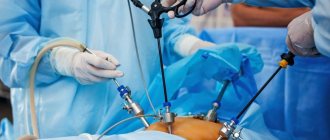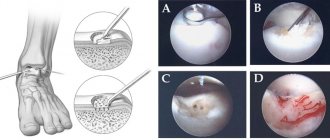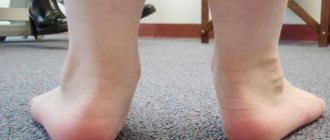Briefly about the treatment method
Phlegmon of the foot is a very dangerous complication of diabetes mellitus and often leads to loss of a limb or even sepsis. Proper surgical treatment of a suppurating foot is a necessary method of preserving the limb. When opening a phlegmon, all leaks must be opened, dead tissue must be removed, and conditions must be created to prevent further spread of the purulent process. The operation is performed under spinal anesthesia. Wounds do not close after opening a purulent focus. Subsequently, the wound on the foot heals either on its own, or various plastic options are used. An important condition for wound healing is the restoration of good blood flow to the foot.
Forms of inflammation
With the development of phlegmon, the inflammatory process goes through several stages of formation. The initial stage is serous. With serous phlegmon, fluid—exudate—forms and accumulates under the skin, and leukocytes penetrate into the cells of the adipose tissue. Fatty tissue takes the form of jelly, completely saturated with exudate. There is a gradual spread of inflammation to healthy areas of soft tissue. If treatment is not carried out at this stage, the phlegmon passes into the next stage, putrefactive or purulent. It depends on what type of pathogenic microflora led to inflammation.
The purulent form provokes histolysis (in which the tissues melt and fill with pus). Due to histolysis, fluid begins to accumulate and may be greenish, cloudy white or yellow. The purulent type of neoplasm can lead to ulcers and fistulas. Without timely treatment, inflammation of purulent masses spreads to healthy tissue, cartilage and bones. At this stage of development of the inflammatory process, the muscles become loose, completely surrounded by pus, and appear gray and dirty. There is no internal bleeding.
The putrefactive form of phlegmon is characterized by rapid infection of soft tissues, which begin to deteriorate, and an unpleasant odor emanates from them. The tissues become brownish or greenish, their consistency is slippery and loose. With further development of phlegmon, soft tissues turn into a solid liquid mass. The main symptom of the putrefactive form of inflammation is severe intoxication of the body with a rapid deterioration in the patient’s condition.
Necrotic phlegmon is the death of destroyed soft tissues that are completely affected by purulent masses. If the tissues do not melt on their own, the body begins to reject them. At this stage of development of phlegmon, the inflammatory process begins to localize, multiple foci of abscess are formed, which can be opened independently. If there is too much accumulation of purulent masses that are deep under the skin, it is necessary to surgically open them and install drainage.
Anaerobic is the most severe stage of phlegmon, in which purulent masses infect adjacent healthy tissues, leading to their death, and gas is released. The fabrics have a fetid odor and are dark gray in color. If you press on the phlegmon, you can hear a crunch with which gas bubbles burst. The skin surrounding the source of inflammation becomes soft and loose, there is no redness.
Possible complications
Cellulitis is an extremely dangerous condition of the body, which without proper treatment can lead to severe intoxication and death of large areas of soft tissue. Chronic phlegmon is characterized by the absence of pronounced symptoms. The slow growth of pathogenic microflora allows the body to fight inflammation. During an exacerbation, a thickening occurs under the skin caused by the accumulation of infiltrate, which becomes woody. The skin around the inflammation becomes bluish.
The development of phlegmon on the lymph nodes is especially dangerous. This condition is fraught with the development of blood clots and sepsis. If the inflammatory process has not been completely treated and a small amount of pus remains on the soft tissues, a repeated purulent abscess may occur. Cellulitis that occurs on the face can lead to purulent meningitis.
cellulitis of the century
With further development of phlegmon, during which healthy tissues are affected, purulent arthritis, pleurisy, and osteomyelitis may occur. The most severe complication is the development of purulent arteritis, in which inflammation of the walls of large blood vessels - arteries - occurs, as a result of which the vessel begins to stratify and disintegrate. This pathological process can lead to severe internal bleeding.
Advantages of treatment at the ISC
Our clinic has adopted active tactics aimed at maximizing limb preservation. In the presence of a purulent process, the first stage is a full-fledged surgical treatment, with the opening of all purulent leaks and removal of dead tissue. Then full blood flow is restored, after which reconstructive plastic surgery is performed to close the wounds on the foot. This tactic allows you to preserve a supporting limb in most patients with diabetic phlegmon.
Diagnostics
To confirm the diagnosis, the doctor collects anamnesis, examines the patient and sends him for additional examination. During the conversation, the specialist finds out whether the person has had any injuries, damage to the skin, calluses, or whether he was wearing uncomfortable shoes. After this, he examines the sore leg and palpates it. This allows you to assess the presence of swelling, redness of the skin, pain, fluctuation. If phlegmon is suspected, the following studies are prescribed:
- General blood analysis. Neutrophilic leukocytosis and increased ESR indicate an inflammatory process in the body, which indirectly confirms the diagnosis;
- Puncture of phlegmon. The site of inflammation is punctured using a syringe. If during the study a thick yellowish liquid was obtained, there is no longer any doubt about the diagnosis;
- Bacteriological examination of punctate. The pus obtained during a biopsy is sent for analysis to identify the pathogen and determine its sensitivity to antibiotics. This is necessary for rational antibiotic therapy.
Immediately after confirming the diagnosis, the doctor prescribes appropriate treatment. Acute cellulitis is always treated surgically.
Preparing for treatment
Surgery for phlegmon of the foot is carried out for emergency reasons, since the process of spreading the infection can be very rapid.
For the purpose of preoperative diagnosis and preparation, the following activities are carried out:
- Ultrasound of arteries and veins of the lower extremities
- X-ray of the foot bones
- ECG, examination by a therapist
- General blood and urine analysis
- Biochemical blood test (urea, creatinine, total protein)
- Bladder catheterization
- Installation of an epidural catheter for pain relief
After all these examinations are completed, the patient is taken to the operating room.
Symptoms
Characteristic signs of phlegmon are severe arching pain, a local increase in temperature, swelling and redness of the skin in the foot area. Painful sensations intensify with pressure, finger movements and walking, which greatly prevents people from doing their usual activities. Due to swelling, a person cannot wear daily shoes. Also characteristic of phlegmon of the foot:
- the appearance of fluctuations, indicating the accumulation of pus;
- an increase in the size of the foot and smoothness of its arch;
- general weakness, apathy, increased sweating and thirst;
- increase in body temperature to 38-39 degrees or more;
- inflammation of regional lymph nodes (popliteal, inguinal).
Swelling of the left foot with phlegmon. Fluctuation can be detected by lightly squeezing the affected foot. In this case, there is a feeling that liquid is moving freely under your hand. Fluctuation also occurs with boils, carbuncles, and abscesses. This symptom indicates the accumulation of pus in the tissues, which requires immediate surgical intervention. In case of chronic phlegmon, which is caused by weakly virulent strains of strepto-, staphylo-, and pneumococcus, all these symptoms may not exist at all. On the foot it is possible to detect only an infiltrate of a woody consistency. The skin over such phlegmon most often acquires a bluish tint.
How the treatment method works
After processing the surgical field, the surgeon makes an incision in the place of greatest fluctuation (fluctuation), where the maximum accumulation of pus is usually observed. After opening and emptying the purulent cavity, it is washed with antiseptic solutions. Before this, the pus must be cultured for microflora.
After cleansing, the surrounding tissues are examined. All areas of questionable viability must be removed; if there are open interosseous joints, then such fingers must be removed.
If the infection spreads along the tendon, it is necessary to make an additional incision higher up the tendon, away from its purulent lesion. After this, the tendon is divided and its affected end is removed through the wound on the foot.
During an operation to open phlegmon, surgeons are guided by the principle of not leaving anything doubtful. The foot wound will heal if the infection is stopped and blood flow is restored.
Phlegmon
This disease is life-threatening and requires emergency hospitalization. During the treatment process, a strict rule applies: if there is pus, it must be evacuated, so the main treatment measure is surgical intervention - opening and draining the purulent focus. An exception to the general rule is the initial stage of phlegmon (before the formation of infiltrate). In this case, the operation is not performed. Patients are prescribed thermal procedures (sollux, heating pads, warming compresses), UHF therapy or compresses with yellow mercury ointment (Dubrovin bandage). The simultaneous use of UHF and mercury ointment is contraindicated.
The presence of high temperature and formed infiltrate is an indication for surgical treatment of phlegmon even in the absence of obvious fluctuation in the lesion. Opening and draining the area of inflammation allows you to reduce tissue tension, improve tissue metabolism and create conditions for the evacuation of inflammatory fluid. Surgery is performed under general anesthesia. The opening of the phlegmon is carried out with a wide incision. At the same time, in order to ensure a good outflow of pus, not only superficial but also deep tissues are widely dissected. After the purulent fluid has drained, the cavity is washed and drained with rubber outlets, tubes or half-tubes.
Dress the wound with a hypertonic solution or water-soluble ointments containing antibiotics. Vaseline-lanolin and fat-based ointments (synthomycin emulsion, Vishnevsky ointment, neomycin, tetracycline ointments, etc.) are not indicated in the early stages, since they impede the outflow of wound contents. In order to accelerate the rejection of dead areas, special necrolytic agents are used - proteolytic enzymes (proteases, chymotrypsin, trypsin) or ointments containing enzymes.
After cleansing the wound cavity, ointment dressings are used. To stimulate regeneration, troxevasin and methyluracil ointments are used, fat-based ointments are used to protect granulation tissue from damage, and water-soluble ointments are used to prevent re-infection. During the epithelization and scarring phase, rosehip and sea buckthorn oils are applied. For long-term non-healing wounds and extensive defects, dermoplasty is performed.
Simultaneously with local treatment, conservative therapy is carried out, aimed at increasing the body's defenses, fighting infection and intoxication. The patient is prescribed bed rest. The affected area is given an elevated position if possible. Painkillers are usually administered intramuscularly. All patients must undergo antibiotic therapy. Drugs are selected taking into account the sensitivity of the pathogen. For anaerobic phlegmon, anti-gangrenous serums are used intramuscularly or subcutaneously.
To regulate the acid-base state of the blood and neutralize toxins, a solution of methenamine is administered intravenously; to improve vascular tone, a solution of calcium chloride is administered. To improve nutrition of the heart muscle, glucose solution is used intravenously. If necessary, drugs are used that normalize the activity of the cardiovascular system (caffeine, etc.). Prescribe plenty of fluids, intravenous infusion therapy, vitamin therapy, restoratives and immunomodulatory drugs. Antibiotic therapy is continued until the acute inflammation is eliminated.
Possible complications during treatment
Surgery for phlegmon of the foot can be complicated by both local and systemic problems. Local complications include bleeding and ongoing infection in the foot. Systemic complications include sepsis, pulmonary embolism, and perioperative infarction.
Considering that patients with diabetic foot phlegmon most often suffer from many concomitant diseases, their risk of systemic complications is quite high. However, it is not connected with the technique of the operation being performed, but with the reason for which it is performed.
Patients with diabetic cellulitis are patients who require intensive care, the prescription of modern antibiotics and the fastest possible restoration of blood flow.
Causes
The cause of the development of phlegmon of the foot is the penetration of pathogenic microorganisms into the tissues of the foot. The disease very often occurs in people with diabetes, since their microcirculation and tissue regeneration in the lower extremities are impaired. Individuals with immunodeficiency are also highly susceptible to this disease as their body is unable to fight off the infection. The most common causes of phlegmon are:
- stab, lacerations, cuts, gunshot wounds;
- penetration of foreign bodies into the tissues of the foot;
- regular foot injuries from tight, uncomfortable shoes;
- various scratches, abrasions, calluses;
- untimely treatment of other purulent foot diseases.
Pathogenic microorganisms most often enter tissues through damaged skin due to injuries, cuts, or punctures. Less commonly, microbes penetrate from foci of chronic infection through the lymphogenous or hematogenous route. Harmful microorganisms cause inflammation and accumulation of pus. Cellulitis does not have a capsule, but it is usually limited to the fascial sheaths of the foot.
Prognosis after treatment method
Predicting the outcome of treatment for diabetic phlegmon is quite difficult. This outcome depends on many factors - general health, the state of the immune system, the ability to restore blood flow and close wounds.
Our practice shows that with timely surgery to open the phlegmon and restore blood flow, it is possible to save the supporting limb in 75% of patients. Mortality is about 5% and is associated with worsening concomitant diseases.
Types of inflammation
Depending on how and why phlegmon arose, inflammation can be primary and secondary. The primary type of phlegmon is an independent disease that occurs due to the penetration of pathogenic microflora into the body, the development of which is accelerated against the background of a weak immune system. Secondary phlegmon occurs as a result of the spread of purulent masses through the soft tissues of internal organs due to a burst boil, abscess and other accumulations of purulent masses.
The incubation period, signs and possible complications depend on the type of soft tissue destruction. There are several types of phlegmon - serous, putrefactive, necrotic and purulent. This type of inflammatory process with the accumulation of purulent masses can spread throughout the body, forming on the muscles, in the abdominal cavity, between internal organs, and under the skin. There is phlegmon of the shoulder, foot, and neck.
Each erysipelas has its own name, depending on its location. It consists of two words - the prefix “para”, which means “about”, and the name of the organ in Latin, in the soft tissues of which inflammation has occurred. For example, phlegmon on the tissues of the rectum is paraproctitis, accumulation of pus between organs in the pelvis is parametritis. An abscess that occurs on soft tissues near the kidneys is paranephritis. The cause of phlegmon on the kidneys is untreated infectious diseases of the genitourinary system, which were accompanied by inflammatory processes.
In the absence of timely treatment in the early stages of the development of purulent inflammation, phlegmon can spread throughout the body, affecting the soft tissues of not only internal organs, but also the thighs, legs, perineum, upper and lower extremities.
How inflammation manifests itself
The symptomatic picture of phlegmon depends on its type. Chronic inflammation does not have pronounced signs in the first stages of development and does not particularly bother a person until the purulent masses have fully matured. In acute phlegmon, symptoms increase quickly, the incubation period lasts no more than a day:
- a sharp increase in temperature up to 40°C;
- fever and chills;
- Strong headache;
- prostration;
- constant feeling of thirst;
- enlarged lymph nodes;
- muscle pain;
- aching joints.
phlegmon of the leg.
The place where purulent masses accumulate, for example, if it is phlegmon of the shoulder, begins to rapidly swell and turn red. Any movement of the limb brings pain, at first slight, and with the development of inflammation the patient is no longer able to move his arm due to severe pain. Upon palpation, phlegmon is easily palpable. The accumulation of purulent masses is a solid, hot formation that does not have clear boundaries. The skin over the site of inflammation begins to become shiny.
As soon as the phlegmon matures, the inflammation bursts. Pus may come out in the form of a fistula (better known as a boil). The danger is erysipelas, when ruptured, the pus does not come to the surface of the skin, but penetrates deeper, spreading to the internal tissues of neighboring organs, causing destruction of the muscular system and bones. With internal infection, the patient experiences:
- severe weakness;
- blood pressure rises;
- shortness of breath, chills, internal heat occurs;
- the condition is rapidly deteriorating;
- pressure drops;
- the pulse is weakly palpable;
- headache increases;
- kidney function is impaired;
- the amount of urine decreases significantly.
In particularly severe conditions, the fingers on the upper and lower extremities turn blue, the skin becomes yellowish due to liver dysfunction.







